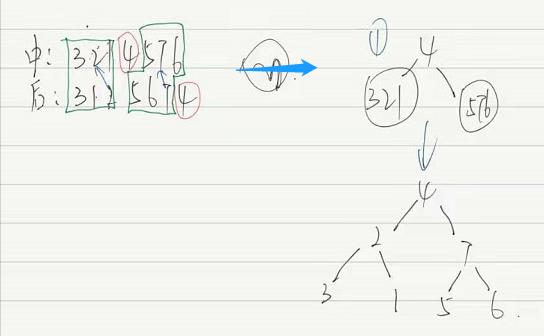二叉树的中后序遍历构建及求叶子
Posted 一腔诗意醉了酒
tags:
篇首语:本文由小常识网(cha138.com)小编为大家整理,主要介绍了二叉树的中后序遍历构建及求叶子相关的知识,希望对你有一定的参考价值。
题目描述
按中序遍历和后序遍历给出一棵二叉树,求这棵二叉树中叶子节点权值的最小值。
输入保证叶子节点的权值各不相同。
输入
第一行输入一个整数t,表示有t组测试数据。
对于每组测试数据,首先输入一个整数N (1 <= N <= 10000),代表二叉树有N个节点,接下来的一行输入这棵二叉树中序遍历的结果,最后一行输入这棵二叉树后序遍历的结果。
输出
对于每组测试数据,输出一个整数,代表二叉树中叶子节点权值最小值。
样例输入
3
7
3 2 1 4 5 7 6
3 1 2 5 6 7 4
8
7 8 11 3 5 16 12 18
8 3 11 7 16 18 12 5
1
255
255
样例输出
1
3
255
解题关键:
先明确,我们建树一般是通过前序遍历的顺序建的。
前序遍历: 根–>左孩子 --> 右孩子
中序遍历: 左孩子–>根 --> 右孩子
后序遍历: 左孩子 --> 右孩子–>根
所以,当我们已知中序遍历以及后序遍历的结果时,我们就可以通过找出一定的规律解题,比如后序遍历的结果的最后一个元素一定是根节点。
如图:

我们发现,在中序遍历结果中,根节点的左边元素为左子树,右元素是右子树。故可以递归得出最后的建树结果。
附:例题C++代码
#include<iostream>
#include<algorithm>
using namespace std;
int *m;
int *h;
int len;
int ans;
class BiTreeNode{
public:
int data;
BiTreeNode *lChild;
BiTreeNode *rChild;
BiTreeNode():lChild(NULL),rChild(NULL){};
~BiTreeNode(){};
};
class BiTree{
private:
BiTreeNode *root;
BiTreeNode * createBiTree(int *mid, int *last, int n);
void getMin(BiTreeNode *t);
public:
BiTree(){};
~BiTree(){};
void createTree();
void getMin();
};
void BiTree::createTree(){
root = createBiTree(m,h,len);
}
BiTreeNode* BiTree::createBiTree(int *mid, int *last, int n){
if(n==0){
return NULL;
}
BiTreeNode* T = new BiTreeNode();
int i;
T->data = last[n-1];
for(i=0; mid[i]!=last[n-1]; i++);
T->lChild = createBiTree(mid,last,i);
T->rChild = createBiTree(mid+i+1,last+i, n-i-1);
return T;
}
void BiTree::getMin(){
getMin(root);
}
void BiTree::getMin(BiTreeNode *t){
if(t){
if(!t->lChild && !t->rChild){
ans = min(ans,t->data);
}
getMin(t->lChild);
getMin(t->rChild);
}
}
int main(){
int Nt;
cin >> Nt;
while(Nt--){
ans = 99999999;
cin>>len;
m = new int[len];
h = new int[len];
for(int i=0; i<len; i++){
cin>>m[i];
}
for(int i=0; i<len; i++){
cin>>h[i];
}
BiTree *bt = new BiTree();
bt->createTree();
bt->getMin();
cout<<ans<<endl;
}
return 0;
}
以上是关于二叉树的中后序遍历构建及求叶子的主要内容,如果未能解决你的问题,请参考以下文章